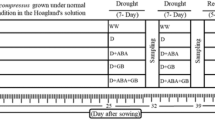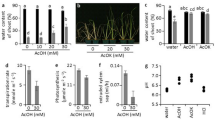Abstract
Water availability is a key determinant of terrestrial plant productivity. Many climate models predict that water stress will increasingly challenge agricultural yields and exacerbate projected food deficits. To ensure food security and increase agricultural efficiency, crop water productivity must be increased. Research over past decades has established that the phytohormone abscisic acid (ABA) is a central regulator of water use and directly regulates stomatal opening and transpiration. In this study, we investigated whether the water productivity of wheat could be improved by increasing its ABA sensitivity. We show that overexpression of a wheat ABA receptor increases wheat ABA sensitivity, which significantly lowers a plant’s lifetime water consumption. Physiological analyses demonstrated that this water-saving trait is a consequence of reduced transpiration and a concomitant increase in photosynthetic activity, which together boost grain production per litre of water and protect productivity during water deficit. Our findings provide a general strategy for increasing water productivity that should be applicable to other crops because of the high conservation of the ABA signalling pathway.
This is a preview of subscription content, access via your institution
Access options
Access Nature and 54 other Nature Portfolio journals
Get Nature+, our best-value online-access subscription
$29.99 / 30 days
cancel any time
Subscribe to this journal
Receive 12 digital issues and online access to articles
$119.00 per year
only $9.92 per issue
Buy this article
- Purchase on Springer Link
- Instant access to full article PDF
Prices may be subject to local taxes which are calculated during checkout




Similar content being viewed by others
Data availability
Newly identified wheat ABA receptors (TaPYLs) were deposited in NCBI databases: TaPYL1, MG273651; TaPYL3, MG273653; TaPYL6, MG273656; TaPYL7, MG273657; TaPYL8, MG273658; and TaPYL9, MG273659. To update TaPYL2, TaPYL4 and TaPYL5 information, MG273652, MG273654 and MG273655, respectively, were also deposited. The wheat reference gene annotation and sequence (International Wheat Genome Sequencing Consortium version 1.1) are available at https://wheat-urgi.versailles.inra.fr/Seq-Repository/Annotations. The raw sequence and processed data for our RNA-Seq analysis were deposited in the NCBI Gene Expression Omnibus database under the specific accession number GSE79522.
Change history
24 April 2023
A Correction to this paper has been published: https://doi.org/10.1038/s41477-023-01416-x
References
Pennisi, E. The blue revolution, drop by drop, gene by gene. Science 320, 171–173 (2008).
Morison, J. I. L., Baker, N. R., Mullineaux, P. M. & Davies, W. J. Improving water use in crop production. Phil. Trans. R. Soc. B 363, 639–658 (2008).
Cutler, S. R., Rodriguez, P. L., Finkelstein, R. R. & Abrams, S. R. Abscisic acid: emergence of a core signaling network. Annu. Rev. Plant Biol. 61, 651–679 (2010).
Kim, T. H., Böhmer, M., Hu, H., Nishimura, N. & Schroeder, J. I. Guard cell signal transduction network: advances in understanding abscisic acid, CO2, and Ca2+ signaling. Annu. Rev. Plant Biol. 61, 561–591 (2010).
Park, S. Y. et al. Abscisic acid inhibits type 2C protein phosphatases via the PYR/PYL family of START proteins. Science 324, 1068–1071 (2009).
Ma, Y. et al. Regulators of PP2C phosphatase activity function as abscisic acid sensors. Science 324, 1064–1068 (2009).
Fujii, H. et al. In vitro reconstitution of an abscisic acid signaling pathway. Nature 462, 660–664 (2009).
Geiger, D. et al. Activity of guard cell anion channel SLAC1 is controlled by drought-stress signaling kinase-phosphatase pair. Proc. Natl Acad. Sci. USA 106, 21425–21430 (2009).
Brandt, B. et al. Reconstitution of abscisic acid activation of SLAC1 anion channel by CPK6 and OST1 kinases and branched ABI1 PP2C phosphatase action. Proc. Natl Acad. Sci. USA 109, 10593–10598 (2012).
Helander, J. D., Vaidya, A. S. & Cutler, S. R. Chemical manipulation of plant water use. Bioorg. Med. Chem. 24, 493–500 (2016).
Santiago, J. et al. Modulation of drought resistance by the abscisic acid receptor PYL5 through inhibition of clade A PP2Cs. Plant J. 60, 575–588 (2009).
Yang, Z. et al. Leveraging abscisic acid receptors for efficient water use in Arabidopsis. Proc. Natl Acad. Sci. USA 113, 6791–6796 (2016).
Kim, H. et al. Overexpression of PYL5 in rice enhances drought tolerance, inhibits growth, and modulates gene expression. J. Exp. Bot. 65, 453–464 (2014).
Yu, J. et al. Overexpression of pyrabactin resistance-like abscisic acid receptors enhances drought, osmotic, and cold tolerance in transgenic poplars. Front. Plant Sci. 8, 1752 (2017).
Zhao, C. et al. Temperature increase reduces global yields of major crops in four independent estimates. Proc. Natl Acad. Sci. USA 114, 9326–9331 (2017).
IWGSC, A chromosome-based draft sequence of the hexaploid bread wheat (Triticum aestivum) genome. Science 345, 1251788 (2014).
Montenegro, J. D. et al. The pangenome of hexaploid bread wheat. Plant J. 90, 1007–1013 (2017).
Jordan, K. W. et al. A haplotype map of allohexaploid wheat reveals distinct patterns of selection on homoeologous genomes. Genome Biol. 16, 48 (2015).
Ji, X. et al. Control of abscisic acid catabolism and abscisic acid homeostasis is important for reproductive stage stress tolerance in cereals. Plant Physiol. 156, 647–662 (2011).
Farquhar, G. D., Ehleringer, J. R. & Hubick, K. T. Carbon isotope discrimination and photosynthesis. Annu. Rev. Plant Physiol. Plant Mol. Biol. 40, 503–537 (1989).
Sharkey, T. D., Bernacchi, C. J., Farquhar, G. D. & Singsaas, E. L. Fitting photosynthetic carbon dioxide response curves for C3 leaves. Plant Cell Environ. 30, 1035–1040 (2007).
Nemali, K. S. et al. Physiological responses related to increased grain yield under drought in the first biotechnology-derived drought-tolerant maize. Plant Cell Environ. 38, 1866–1880 (2015).
Cooper, M., Gho, C., Leafgren, R., Tang, T. & Messina, C. Breeding drought-tolerant maize hybrids for the US corn-belt: discovery to product. J. Exp. Bot. 65, 6191–6204 (2014).
Bowne, J. B. et al. Drought responses of leaf tissues from wheat cultivars of differing drought tolerance at the metabolite level. Mol. Plant 5, 418–429 (2012).
Ogbonnaya, F. C. et al. in Plant Breeding Reviews (ed. Janick, J.) 35–122 (Wiley-Blackwell, Hoboken, 2013).
Huang, B. E. et al. A multiparent advanced generation inter-cross population for genetic analysis in wheat. Plant Biotech. J. 10, 826–839 (2012).
Krasileva, K. V. et al. Uncovering hidden variation in polyploid wheat. Proc. Natl Acad. Sci. USA 114, E913–E921 (2017).
Kikuchi, J. et al. SpinCouple: development of a web tool for analyzing metabolite mixtures via two-dimensional J-resolved NMR database. Anal. Chem. 88, 659–665 (2016).
Mori, T. et al. Multidimensional high-resolution magic angle spinning and solution-state NMR characterization of 13C-labeled plant metabolites and lignocellulose. Sci. Rep. 5, 11848 (2015).
R Core Development Team R: A Language and Environment for Statistical Computing (R Foundation for Statistical Computing, 2014).
Acknowledgements
We thank Y. Kano, T. Shimizu and Y. Imai (Tottori University) for facility maintenance, W. Yamori (The University of Tokyo) and K. Hikosaka (Tohoku University) for advice on photosynthetic analyses, M. Inoue (Tottori University) for help with calculations of SWP from SWC, and K. Shimamoto (Nara Institute of Science and Technology) for providing the p2K-1GW plasmid. We also express our gratitude to the CIMMYT and ICARDA for providing wheat cultivar seeds, and thank the NBRP for providing TaPYL4 complementary DNA. This work was supported by grants from JST PRESTO (JPMJPR15Q5 to M.O.), KAKENHI (17H05009 to M.O.), Project Marginal Region Agriculture of Tottori University (to H.T. and M.O.), the Joint Research Program of Arid Land Research Center, Tottori University (30C2007 to M.O.), the NSF (IOS1258175 and 1656890 to S.R.C.) and the Cooperative Research Grant of the Genome Research for BioResource, NODAI Genome Research Center, Tokyo University of Agriculture.
Author information
Authors and Affiliations
Contributions
R.M. and M.O. conceived the project and planned the experiments. F.A. generated the TaPYLox lines. K.T., H.K. and Y.S. performed the RNA-Seq experiments. J.-S.K. analysed the data. Y.T. and J.K. performed the NMR experiments and data analysis. H.T. provided wheat materials and supervised the research. J.-S.K. and K.H. searched for fragment sequences of TaPYLs in the draft wheat genome. R.M. and M.O. performed all of the other experiments. R.M., S.R.C. and M.O. wrote the manuscript. All authors commented on the manuscript.
Corresponding author
Ethics declarations
Competing interests
The authors declare no competing interests.
Additional information
Publisher’s note: Springer Nature remains neutral with regard to jurisdictional claims in published maps and institutional affiliations.
Supplementary information
Supplementary Information
Supplementary Figures 1–12, Supplementary Video Legend, Supplementary Methods and Supplementary References.
Supplementary Table 1
Identified Ta PYLs and TaPP2Cs superimposed on the current wheat genome (IWGSC.v1). TPM values were derived from three biologically independent samples. FDR was calculated using LRT built-in function of Sleuth v0.44 for multiple comparison.
Supplementary Table 2
Differential gene expression between Null and L8 under well-watered, ABA-treated and water-deficient conditions (WWC, ABA and drought, respectively; n = 3 biologically independent samples). FDR was calculated using LRT built-in function of Sleuth v0.44 for multiple comparison.
Supplementary Table 3
Actual copy numbers of heatmaps shown in Fig. 1c and d. Data are mean ± s.d. (n = 3 biologically independent samples).
Supplementary Table 4
Primers used in this study.
Supplementary Video 1
A movie showing the gradual wilting of four types of cultivars.
Rights and permissions
About this article
Cite this article
Mega, R., Abe, F., Kim, JS. et al. Tuning water-use efficiency and drought tolerance in wheat using abscisic acid receptors. Nat. Plants 5, 153–159 (2019). https://doi.org/10.1038/s41477-019-0361-8
Received:
Accepted:
Published:
Issue Date:
DOI: https://doi.org/10.1038/s41477-019-0361-8
This article is cited by
-
Crop traits and production under drought
Nature Reviews Earth & Environment (2024)
-
Genome-wide identification of the PYL gene family of tea plants (Camellia sinensis) revealed its expression profiles under different stress and tissues
BMC Genomics (2023)
-
GhPYL9-5D and GhPYR1-3 A positively regulate Arabidopsis and cotton responses to ABA, drought, high salinity and osmotic stress
BMC Plant Biology (2023)
-
Metabolic and transcriptomic profiling during wheat seed development under progressive drought conditions
Scientific Reports (2023)
-
Proposing an ensemble machine learning based drought vulnerability index using M5P, dagging, random sub-space and rotation forest models
Stochastic Environmental Research and Risk Assessment (2023)



